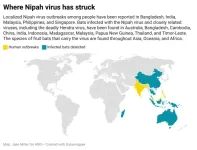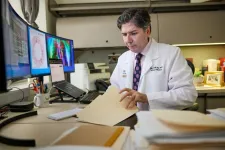(Press-News.org) Scientists at Harvard Medical School and Boston University Chobanian & Avedisian School of Medicine have mapped a critical component of the Nipah virus, a highly lethal bat-borne pathogen that has caused outbreaks in humans almost every year since it was identified in 1999.
The advance, described Jan. 20 in Cell, brings scientists a step closer to developing much-needed medicines. Currently, there are no vaccines to prevent or mitigate infection with the Nipah virus and no effective treatments for the disease other than supportive care.
The virus, harbored by fruit bats, can be transmitted to pigs and to humans. It can also infect people through contaminated food and can travel directly from person to person via droplets released when coughing. The World Health Organization has declared Nipah virus a priority pathogen, a designation given to organisms that can cause serious outbreaks and require urgent research to inform prevention and treatment strategies.
Nipah virus has the potential to ignite a pandemic, researchers say, because it can spread via airborne droplets and respiratory secretions. Additionally, the researchers note, evidence hints that some infected people who develop milder, nonspecific symptoms may still transmit the virus.
In severe cases, the infection can cause serious respiratory illness and encephalitis, a form of brain inflammation that can lead to devastating neurologic deficits and death. The virus kills between 40 and 75 percent of those infected, according to estimates from the Centers for Disease Control and Prevention. By comparison, Ebola virus kills between 25 and 90 percent of those infected in past outbreaks, with an average death rate of 50 percent.
In the new study, researchers homed in on a part of the viral machinery called the viral polymerase complex, a group of proteins the virus uses to copy its genetic material, spread, and infect cells. The work provides a detailed three-dimensional picture of the virus’s polymerase and its key features. Understanding the structure and behavior of this critical piece of the viral machinery illuminates how the pathogen multiplies inside its hosts.
Until now, the structure and function of the Nipah virus polymerase remained poorly understood, researchers said, cautioning that further research would be needed to fully understand how the polymerase makes the different types of genetic materials that enable the virus to multiply.
Nonetheless, the team said, unraveling this piece of the viral apparatus is the critical first step toward profiling the inner workings of a virus that poses a serious threat.
“Identifying how the polymerase is regulated to switch on and switch off the different enzymatic activities that are required for viral replication would be game-changing, and this study represents a key step towards that goal,” said study co-corresponding author Rachel Fearns, Chair and Ernest Barsamian Professor of Virology, Immunology & Microbiology at the Boston University Chobanian & Avedisian School of Medicine.
Unraveling the molecular structure of the viral polymerase complex provides a foundation that can inform the design of treatments.
“This new understanding can help us identify the functional properties of the polymerase structure that could be leveraged as drug targets,” said co-corresponding author Jonathan Abraham, associate professor of microbiology at Harvard Medical School and an investigator of the Howard Hughes Medical Institute.
Once the researchers worked out the structure of the enzyme, they took a closer look at how different parts of the enzyme affect the different functions that it performs. Understanding the roles of these different parts and how they can adopt different positions offers critical clues for how to block the virus’s proliferation.
The researchers conducted the experiments in two different ways. First, they purified the polymerase and determined its structure using cryo-electron microscopy, a technique that allows scientists to visualize the structure of biologic samples at the scale of individual molecules. Second, they induced mutations in the polymerase and then observed how the mutated polymerase behaved in cells to understand how these mutations affected its function.
“Elucidating both the unique and shared characteristics of the Nipah virus polymerases in comparison to other viral polymerases, our study provides critical insights that have the potential to inform the development of broad-spectrum antivirals,” said study co-first author Heesu Kim, a researcher in the Fearns Lab.
The researchers note that there is one promising oral drug candidate developed by scientists at Georgia State University that works against viruses related to Nipah but not against Nipah virus itself.
To understand why this drug candidate is ineffective against Nipah virus, the researchers conducted various simulation studies to see whether certain structural tweaks to the viral polymerase would improve the ability of the drug to latch onto the virus. The researchers identified a specific portion of the viral polymerase that could become a drug target. This in turn can inform the design of small-molecule inhibitors that disrupt the viral polymerase and render Nipah virus susceptible to treatment.
“We hope that our findings will spark interest and stimulate additional research by others, enabling new insights into a deadly pathogen,” said Side Hu, co-first author on the study and a post-doctoral researcher in the Abraham Lab. “Indeed, we were excited to see other groups share their data openly just as we did and help move the field forward.”
Authorship, funding, disclosures
Additional authors include Pan Yang, Zishuo Yu, Barbara Ludeke, Shawna Mobilia, Junhua Pan, Margaret Stratton, and Yuemin Bian.
This work was supported by an award from the Bill & Melinda Gates Foundation.
Cryo-EM data were collected at the Harvard Cryo-Electron Microscopy Center for Structural Biology at Harvard Medical School.
Fearns is the recipient of a sponsored research agreement with Merck & Co for work on polymerases of related viruses.
END
Scientists uncover structure of critical component in deadly Nipah virus
Findings could inform the design of treatments to combat infection
2025-01-20
ELSE PRESS RELEASES FROM THIS DATE:
Study identifies benefits, risks linked to popular weight-loss drugs
2025-01-20
Demand for weight-loss medications sold under brand names such as Ozempic and Wegovy continues to surge, with a recent study reporting one in eight Americans has taken or is currently using the drugs to treat diabetes, heart disease or obesity.
Formally, these drugs are known as glucagon-like peptide-1 receptor agonists (GLP-1RA) and include Mounjaro and Zepbound. Informally, media, patients and even some physicians have dubbed GLP-1 medications as “miracle drugs” because of the profound weight loss among users. While these health benefits are well established, information is sparse on the drugs’ effects across ...
Ancient viral DNA shapes early embryo development
2025-01-20
Over half of our genomes consists of thousands of remnants of ancient viral DNA, known as transposable elements, which are widespread across the tree of life. Once dismissed as the "dark side" of the genome, researchers at Helmholtz Munich and Ludwig-Maximilians-Universität (LMU) have now revealed their crucial role in early embryo development.
Unanswered Questions About the Role of Ancient Viral DNA
Transposable elements, remnants of ancient viral DNA, are reactivated during the first hours and days following fertilization. ...
New study paves way for immunotherapies tailored for childhood cancers
2025-01-20
Researchers at Karolinska Institutet and the Astrid Lindgren Children’s Hospital in Sweden have determined how children’s immune systems react to different kinds of cancer depending on their age. The study, which is published in the journal Cell, reveals significant differences between the immune response of children and adults, and has the potential to lead to new tailored treatments for children with cancer.
“The activation of the immune system is crucial to our ability to fight cancer, but differs between children and adults,” says Petter Brodin, professor of paediatric immunology at the ...
Association of waist circumference with all-cause and cardiovascular mortalities in diabetes from the National Health and Nutrition Examination Survey 2003–2018
2025-01-20
Background and objectives
Waist circumference (WC) is closely associated with metabolic diseases, including diabetes mellitus (DM), metabolic syndrome, and mortality. However, the correlation between WC and mortality varies across populations and has rarely been examined specifically in patients with DM. In this study, we explored the relationships between WC and both all-cause and cardiovascular mortalities among individuals with DM.
Methods
Participants from the National Health and Nutrition Examination Survey 2003–2018 included 3,151 women and 3,473 men with DM who had baseline WC measurements. Survival data were collected from enrollment until December 31, 2019. ...
A new chapter in Roman administration: Insights from a late Roman inscription
2025-01-20
Archaeologists have uncovered a rare Tetrarchic boundary stone at the site of Abel Beth Maacah in northern Israel. Originally marking land borders under Roman Emperor Diocletian’s tax reforms, the stone provides insight into ancient land ownership, local settlement patterns, and imperial administrative practices. The discovery also introduces two previously unknown place names, expanding our understanding of the region’s historical geography and socio-economic landscape.
Archaeologists Prof. Naama Yahalom-Mack and Dr. Nava Panitz-Cohen from the Institute of Archaeology at the Hebrew University, and Prof. Robert Mullins from Azusa Pacific University have uncovered a significant ...
Global trust in science remains strong
2025-01-20
A global survey spanning 68 countries reveals that public trust in scientists is still high. Led by the University of Zurich and ETH Zurich, a team of 241 researchers conducted the largest post-pandemic study of trust in science, societal expectations and public views on research priorities.
Trust in scientists is at a moderately high level worldwide, according to a new study. This is the conclusion of an international team of 241 researchers led by Viktoria Cologna of ETH Zurich and Niels G. Mede of the University of Zurich (UZH). “Our results show that most people in most countries have a relatively ...
New global research reveals strong public trust in science
2025-01-20
A new international study on public trust in science, conducted across 68 countries, has found that most people trust scientists and believe they should be more involved in society and policymaking. Further, a majority of survey participants believe that scientists should be more involved in society and policymaking.
Published in Nature Human Behaviours (pre print link), this research was conducted by TISP, a Harvard University-based consortium led by Dr Viktoria Cologna (Harvard University, RTH Zurich) and Dr Niels G Mede (University of Zurich), which includes 241 researchers from 169 institutions worldwide, including the University of Bath.
The study, which includes 71,922 respondents—2,008 ...
Inflammation may explain stomach problems in psoriasis sufferers
2025-01-20
People with the skin condition psoriasis often have invisible inflammation in the small intestine with an increased propensity for ‘leaky gut’, according to new research at Uppsala University. These changes in the gut could explain why psoriasis sufferers often have gastrointestinal problems and are more prone to developing Crohn’s disease. The study is published in Biochimica et Biophysica Acta (BBA) – Molecular Basis of Disease.
Psoriasis is a hereditary, chronic skin condition that can also result in inflammation of the joints. In Sweden, almost 300,000 people live with some form of the condition. Chronic inflammatory bowel ...
Guidance on animal-borne infections in the Canadian Arctic
2025-01-20
A new review on zoonotic infections — diseases transmitted by animals — in the Canadian Arctic provides timely guidance to clinicians as the region experiences heightened global interest as well as climate change, which threatens the region and increases risk of disease transmission. The review, published in CMAJ (Canadian Medical Association Journal) https://www.cmaj.ca/lookup/doi/10.1503/cmaj.240541, provides guidance on how to identify and manage seven zoonotic infections in people.
“Indigenous Peoples continue to be caretakers of ...
Fatty muscles raise the risk of serious heart disease regardless of overall body weight
2025-01-20
People with pockets of fat hidden inside their muscles are at a higher risk of dying or being hospitalised from a heart attack or heart failure, regardless of their body mass index, according to research published in the European Heart Journal [1] today (Monday).
This ‘intermuscular’ fat is highly prized in beef steaks for cooking. However, little is known about this type of body fat in humans, and its impact on health. This is the first study to comprehensively investigate the effects of fatty muscles on heart disease.
The new finding adds evidence that existing measures, such as body mass index or waist ...
LAST 30 PRESS RELEASES:
B cells transiently unlock their plasticity, risking lymphoma development
Advanced AI dodel predicts spoken language outcomes in deaf children after cochlear implants
Multimodal imaging-based cerebral blood flow prediction model development in simulated microgravity
Accelerated streaming subgraph matching framework is faster, more robust, and scalable
Gestational diabetes rose every year in the US since 2016
OHSU researchers find breast cancer drug boosts leukemia treatment
Fear and medical misinformation regarding risk of progression or recurrence among patients with breast cancer
Glucagonlike peptide-1 receptor agonists and asthma risk in adolescents with obesity
Reviving dormant immunity: Millimeter waves reprogram the immunosuppressive microenvironment to potentiate immunotherapy without obvious side effects
Safety decision-making for autonomous vehicles integrating passenger physiological states by fNIRS
Fires could emit more air pollution than previously estimated
A new way to map how cells choose their fate
Numbers in our sights affect how we perceive space
SIMJ announces global collaborative book project in commemoration of its 75th anniversary
Air pollution exposure and birth weight
Obstructive sleep apnea risk and mental health conditions among older adults
How talking slows eye movements behind the wheel
The Ceramic Society of Japan’s Oxoate Ceramics Research Association launches new international book project
Heart-brain connection: international study reveals the role of the vagus nerve in keeping the heart young
Researchers identify Rb1 as a predictive biomarker for a new therapeutic strategy in some breast cancers
Survey reveals ethical gaps slowing AI adoption in pediatric surgery
Stimulant ADHD medications work differently than thought
AI overestimates how smart people are, according to HSE economists
HSE researchers create genome-wide map of quadruplexes
Scientists boost cell "powerhouses" to burn more calories
Automatic label checking: The missing step in making reliable medical AI
Low daily alcohol intake linked to 50% heightened mouth cancer risk in India
American Meteorological Society announces Rick Spinrad as 2026 President-Elect
Biomass-based carbon capture spotlighted in newly released global climate webinar recording
Illuminating invisible nano pollutants: advanced bioimaging tracks the full journey of emerging nanoscale contaminants in living systems
[Press-News.org] Scientists uncover structure of critical component in deadly Nipah virusFindings could inform the design of treatments to combat infection




